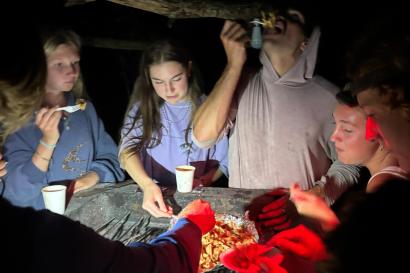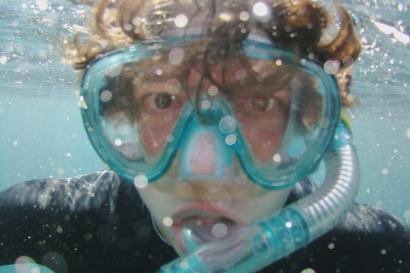
El Lago
I spent last week at the Tiputini Biodiversity Station, a research center located in the Yasuní Biosphere Reserve, deep in the most remote region of the Ecuadorian Amazon. To get there took seven hours of travel by plane, bus, and boat, but the trip was worth its ironically huge carbon footprint (the reserve, on of the most biodiverse wilderness areas in the world, sits on a massive oil field, the tapping of which is a topic of current debate). The most vibrant place on the planet, the tropical rainforest hums and sings with an energy that is simultaneously energizing and humbling, at once electrifying and sacred. It was an awe-inspiring, life-altering week, and on top of all it taught me about the planet’s most complex ecosystem, the jungle brought me back in time.
I awoke during my second night in the jungle, and instead of the constant myriad of sounds from the frogs and the birds and the palm-sized crickets, heard nothing but the roar of a waterfall. The deafening noise was actually the rain, the loudest I’d ever heard, and as I lay on the bunk in a haze of humidity and sleep, I wondered to myself why I hadn’t seen this coming from the rainforest. The torrent was so loud that we couldn’t hear our alarms, but we miraculously awoke without them in the gray dawn of our last full day in the Amazon.
My group of four students pulled on rubber boots (mandatory snake-defenses) and followed our professor onto a trail labeled “El Lago.” Through the dense forest we walked single file, over vine-curled bridges and trail flooded by the night’s storm, stopping to peer up through the canopy at wooly monkeys or down at leaf-cutter ants marching along with their green cut-out cargo. The bromeliads, full of water, sat on damp, liverwort-matted branches like spiky photosynthetic vases. Finally, the trail took us down to an Amazon lake as murky brown as the river, to a single wooden canoe tied to a post at its shore. It was bordered closely by thick vegetation, and something rustled amongst the dense lakeside greenery. As our boat slipped away from shore, I looked up to see a small, feathered dinosaur squawking in the wide-leaved palms.
The Hoatzin is a pheasant-sized bird with a spiky orange crest adorning its head, blood-red eyes surrounded by blue skin, and long tail feathers. Its lineage is a genetic mystery, but it nonetheless provides us with insight into the heavily-debated reptilian saga that is the evolution of birds from dinosaurs. This is because the Hoatzin retains a particularly primitive trait: its chicks possess claws on their wings, a feature found on the famous fossil Archaeopteryx, a legendary “link” between reptiles and modern birds. Though these vestigial claws have been lost in the rest of the avian family, tiny Hoatzins use them to grasp onto branches and clamber back up into the trees when they fall into the water, and they were probably used in a similar manner by Archaeopteryx, the first bird, 100 million years ago in the ancient jungles of the Cretaceous period.

A rendering of the Hoatzin by Etienne Dumont
To watch these bizarre-looking birds fly clumsily amongst the palms, then, may be the closest we can get to seeing a dinosaur. So, I sat in the canoe as our professor paddled quietly, clutching my binoculars and trying not to blink lest I be brought back to the present from this prehistoric lagoon. This ancient lake, this dinosaur’s pensieve! There was not a man-made sound to be heard, only the primeval calls of the Hoatzin, who flaunted their showy, long tail feathers like the stars of some BBC special on prehistoric life.
And as if the trip back through geologic time wasn’t enough of a show, my days in the jungle also revealed more evolutionary recent members of the class Aves, the most colorful birds I’ve ever seen: paradise tanagers, macaws, parrots, toucans. In one week in the Amazon Basin, I looked back 100 million years and was witness to a chapter of the grand and ongoing saga that is reptilian evolution.

Grace Glynn
<p><span style="color: rgb(29, 29, 29); font-family: Arial, Verdana, sans-serif; font-size: 12px; line-height: normal; background-color: rgb(237, 237, 237);">Grace is a junior at Connecticut College with a major in botany. She grew up on the coast of Maine and looks forward to leaving its harsh winter for the equatorial Galapagos Islands. Grace’s interests include paleontology, backpacking, folk music, and fermented foods. Join her as she heads to Ecuador for the semester!</span></p>






